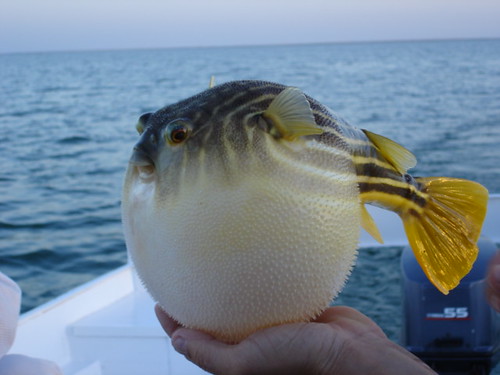The name Pufferfish is used to describe a wide range of different species in the family Tetraodontidae within the order Tetraodontiformes. All these fish species share a remarkable ability to inflate themselves and puff up when they feel frightened. Because of this capacity, they are also commonly known as Blowfish, Balloonfish, Globefish and Swellfish. Pufferfish is related to Porcupinefish; another fish that can puff up when it feels threatened. Unlike the Pufferfish, the Porcupinefish is equipped with spines.
Wild Pufferfish can be found from 45° latitude north to 45° latitude south. A majority of the species lives in saltwater, but some venture into brackish waters and a few species are freshwater dwellers. Marine Pufferfish species are usually found near coral reefs. If you want to find out more about the different Pufferfish species, you can look at the more detailed articles here at Aquaticcommunity.com or regarding more or less frequently kept Pufferfish species. You can also take a look in the species database.
The family Tetraodontidae contains 185 described species and many of them are successfully kept in saltwater aquariums. Species from the genus Arothron are especially popular, but Pufferfish from other genera are also commonly found in aquariums. The species in the genus Arothron are commonly known as Fat Puffers, and they have a very cute look that makes them popular as pets. Their eyes are large, and they can blink as well as vocalise. Many aquarists claim that each Fat Pufferfish develops its own characteristic personally in the aquarium. In the genus Arothron you will find Black-spotted Pufferfish (Arothron nigropunctatus), Guinea Fowl Pufferfish (Arothron meleagris), Immaculate Pufferfish (Arothron immaculatus), Map Pufferfish (Arothron mappa), Masked Pufferfish (Arothron diadematus), Narrow-Lined Pufferfish (Arothron manilensis), Reticulated Pufferfish (Arothron reticularis) and the White Spotted Pufferfish/ Poison Pufferfish (Arothron hispidus).
A Pufferfish is rarely a very good swimmer and it must therefore use other ways of protecting it self from predators. As mentioned earlier in this article, this fish can rapidly inflate itself to surprise and hopefully scare away predators. If this technique fails, the Pufferfish will relay on a very potent toxin named tetrodotoxin (anhydrotetrodotoxin 4-epitetrodotoxin). The eyes as well as most internal organs of a Pufferfish are filled with high levels of this neurotoxin. The liver and ovaries are especially toxic, while skin, muscles, blood and intestines only contain smaller amounts of toxin. This is why Pufferfish can be consumed by humans, as long as the fish is prepared by a skilled and very careful chef. The meat is especially appreciated in Japan and Korea, even though cases of lethal Pufferfish poisoning occur each year in these countries.
The Pufferfish can inflate it self since it has a remarkably flexible and elastic stomach that can be filled with water. If the Pufferfish becomes scared when it is out of water, it will instead suck in air. A puffed up Pufferfish will be nearly spherical. Regardless of whether your Pufferfish is in or out of water, you should always strive not to frighten your fish. Every time a Pufferfish inflate it self, it risks dying since air can become trapped inside its body and prevent it from deflating.
Puffer Fish
Puffer Fish
Puffer Fish
Puffer Fish
Puffer Fish
Puffer Fish
Puffer Fish
Puffer Fish
Puffer Fish
Puffer Fish
Puffer Fish
Puffer Fish
Pablo the puffer fish










No comments:
Post a Comment